Abstract
In recent years, increasing numbers of pink-coloured CVD synthetic diamonds have appeared on the market. One of the major sources is Huzhou SinoC Semiconductor Science and Technology Co., Ltd., Zhejiang province of China. In this article, seven pink-coloured CVD-grown diamonds produced in the last two years by Huzhou have been investigated and identified, including their gemological and spectroscopic characteristics. In DiamondView, they fluoresced orange–red, with an obscure striated growth structure, which is common for CVD synthetics. The mid-IR absorption spectra of these samples showed some single nitrogen and hydrogen-related features (1130, 1344, 3123, 3323 cm−1), which indicated that the diamonds were type Ib and were CVD-grown diamonds. The H1a defect annealed out at approximately 1400 °C, whereas the 3107 cm−1 defect was produced by annealing above 1700 or 1800 °C. This implied that the samples had undergone two separate heat treatments: first, a high-temperature anneal (possibly an HPHT treatment to reduce any brown colour), which would have produced the 3107 cm−1 defects and a small number of A centres, followed by irradiation, followed by annealing above 800 °C to make the vacancies mobile. The UV–Vis–NIR absorption spectra showed distinct NV-related features (575 and 637 nm), the main reason for the pink colour. Photoluminescence spectra obtained at liquid nitrogen temperature recorded radiation-related emissions (388.9, 503.5 nm), a strong N-V centre, H3 and H2 defects, and many unassigned emissions. These pink CVD products can be separated from natural and treated pink-coloured diamonds by a combination of optical spectroscopic properties, such as fluorescence colour, and absorption features in the infrared and UV–Vis regions.
1. Introduction
Most as-grown and gem-quality CVD-grown diamonds are colourless, near colourless, or brown, with varying degrees of saturation. Other colours can be produced by introducing other colour centres or defects either during the growth process or with post-growth treatment. Pink CVD synthetic diamonds were reported first in 2007 and appeared on the gem market around 2010 [1,2]. Many of these samples have been studied by gemmologists and described in detail in previous articles [1,2,3,4,5,6]. They constitute a large proportion of sought-after coloured CVD synthetic diamonds. Their hues include a variety of colour descriptions, such as pinkish brown, brownish pink, pink, purplish pink, and orangey pink [6]. Among these pink CVD synthetic diamonds, only a few samples are mainly coloured by a broad absorption band at ~520 nm [1], while most are coloured by nitrogen vacancy (NV) centres after post-growth treatments.
In the past several years, significant progress has been made with synthetic diamonds produced by the chemical vapour deposition (CVD) method in China [7,8,9]. Not only have CVD diamonds with larger sizes and in better qualities been produced (larger than 10 ct polished CVD diamond was produced by Shanghai Zhengshi Technology in Shanghai city of China) in the as-grown material, but multiple treatments have been applied to some CVD synthetic diamonds to improve their colour after initial growth [8]. In this article, we will discuss several sought-after pink CVD-grown diamonds from the Huzhou SinoC Semiconductor Science and Technology Co., Ltd. and present the gemological and spectroscopic properties in detail.
2. Materials and Methods
For this study, HuZhou Sino-C Semiconductor Technology Company provided seven pink or pinkish CVD synthetic diamonds to the National Gemstone Testing Center (China) for examination. The samples ranged from 0.71 ct to 1.38 ct and showed varying saturation of pink colouration. These diamonds are representative of the current pink-coloured production grown at HuZhou Sino-C Semiconductor Technology Company. See Table 1 for a full description of the individual samples.

Table 1.
The gemological information about the pink CVD-grown synthetic diamonds studied in this research.
The following testing and analysis procedures were performed on all samples. A gemological microscope was used to observe the inclusions and anomalous birefringence. Reactions to ultraviolet (UV) radiation were checked in a darkened room with a long-wave (365 nm) and shortwave (253 nm) lamp. Fluorescence, phosphorescence, and growth characteristics were observed with a DiamondView™ instrument developed by the De Beers Group in England. Fourier-transform infrared (FTIR) spectroscopy was performed using a Thermo Nicolet 6700 spectrometer in the range of 6000–400 cm−1 (128 scans at a resolution of 2 cm−1). A QSpec Gem-3000 spectrophotometer was used to obtain ultraviolet–visible–near infrared (UV–Vis–NIR) absorption spectra at room and liquid nitrogen temperature. A Renishaw inVia Raman microspectrometer was used to collect photoluminescence (PL) spectra with four laser excitations (325, 473, 532, 785, and 830 nm) at liquid nitrogen temperature (77 K).
3. Results
All the samples had a distinct pink hue (Figure 1). Some were brownish purple; some were orange pink, and those with the most attractive colour were highly saturated bright pink.
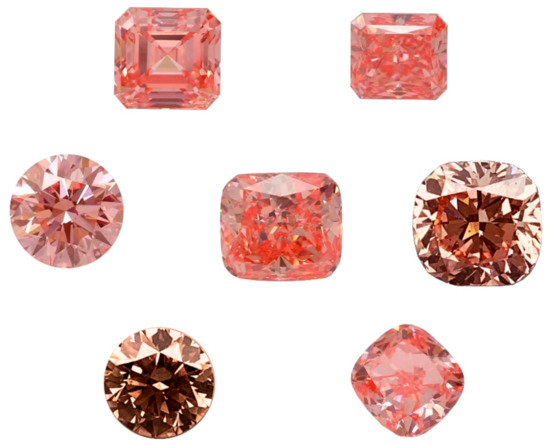
Figure 1.
The pink or pinkish type Ib CVD synthetic diamonds examined for this study were treated by irradiation and annealing. The sample numbers are ZX11, 09, 13, 12, 04, 03, 10, respectively, from left to right and top to bottom. Photos by Z. Song.
In general, all the CVD synthetic diamonds showed an even colour distribution with no visible colour concentrations.
The samples had relatively high clarity; all of them had a VS clarity grade.
Black pinpoints and irregular inclusions were visible with magnification in all samples (Figure 2) and appeared to consist of non-diamond carbon, as described for CVD synthetic diamond by Martineau et al. [10].
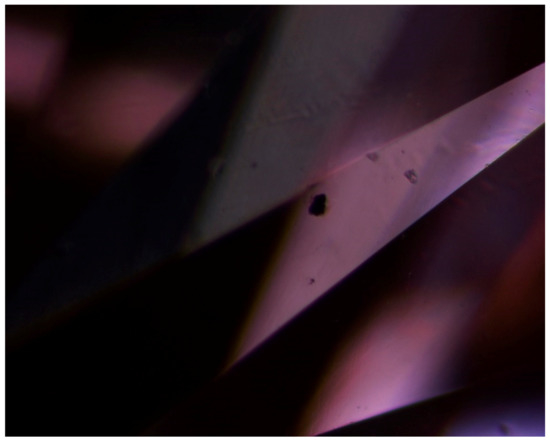
Figure 2.
Black pinpoint and irregular inclusions (probably non-diamond carbon) are present in the most of the CVD synthetic diamonds, as shown here in the ZX03 sample grown by Huzhou SinoC Semiconductor Science and Technology Co., Ltd. In China. Photomicrograph by Z. Song; magnified 50×.
With cross-polarised light, strong birefringence was another important feature of these CVD samples. They all showed low- to moderate-order interference colours (Figure 3). The patterns were linear or grid-like, but not the Tatami structure typical of type IIa natural diamonds [11].
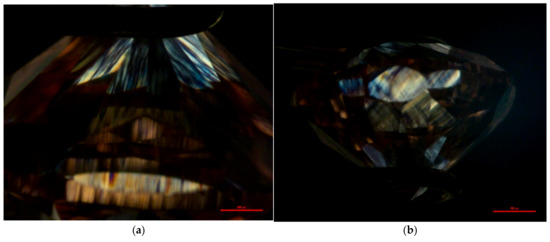
Figure 3.
Strong birefringence is displayed in the ZX04 sample when observed with crossed polarisers. (a) Linear pattern magnified 16×. (b) Grid-like pattern magnified 10×. Photomicrograph by Z. Song.
All of samples showed moderate to strong orange red fluorescence to shortwave UV radiation. No phosphorescence to long or shortwave UV radiation was seen.
3.1. Luminescence Feature
As observed with DiamondView™, all samples showed strong red or orangey red fluorescence (Figure 4). As seen in the table, the fluorescence was evenly distributed; from the pavilion, we can observe the growth striation and the multi-run growth lines. In addition, all samples showed very weak red phosphorescence. The body of the pink CVD synthetic diamonds also changed in colour to brown pink after being observed in DiamondView™ (strong UV irradiation).
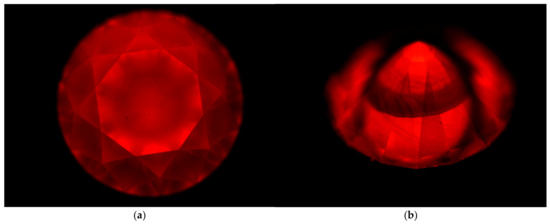
Figure 4.
In DiamondView, these pink CVD diamonds display strong orange or orange red fluorescence. The fluorescence pattern of the ZX03 shown here is indistinct from the table (a), and the characteristic striated growth features are clearly seen from the pavilion (b). Photos by Z. Song.
3.2. Spectroscopic Features
3.2.1. IR Spectra
The typical absorptions were observed in three regions of 1500–1000, 3500–2700, and 9000–5000 cm−1. The main features in the 1500–1000 cm−1 region include the weak and sharp peak at 1344 cm−1 and a broad band at ~1130 cm−1 attributed to single nitrogen, a sharp and relatively strong peak at 1332 cm−1 possibly assigned to N+ [12], and absorption from the H1a defect at 1450 cm−1. The H1a defect is associated with irradiation, and it is subsequently annealed at a relatively low temperature in nitrogen-containing diamonds [13]. In addition, we saw a sharp peak at 1340 cm−1, often observed in CVD diamonds [14]. These absorptions features could be detected in all pink CVD samples, but with variations in intensity. Although the intensity of the 1344 cm−1 peak is very weak (the absorption coefficient was 0.016–0.042 cm−1, corresponding to 0.27–0.71 ppm of isolated nitrogen), we still consider them type Ib diamonds, despite being very close to type IIa.
In the 3500–2700 cm−1 region, four pink CVD samples displayed hydrogen-related peaks at 3107 cm−1 (0.005–0.024 cm−1 in intensity), three samples displayed a weak peak at 3123 cm−1, and two samples displayed a weak peak at 3323 cm−1. All of them displayed 3030 cm−1 absorption, except the sample with 3123 and 3323 cm−1 absorption. Other absorptions in this region included weak peaks at 2948 cm−1 and broad bands at 2904 cm−1 (Figure 5). In addition, a broad band at ~9288 cm−1 could be detected (Figure 5c), which was proven to be related to irradiation [8].

Figure 5.
In the 1000–1500 cm−1 region (a), the mid-infrared spectrum of these pink CVD synthetic diamonds revealed that they are type Ib with a very small concentration of isolated nitrogen. In the 2800–3400 cm−1 region (b), these samples revealed 3123, 3107, and 3030 cm−1 peaks due to hydrogen. In the near-infrared region of 8000–10,000 cm−1 (c), a broad absorption band at the centre of ~9288 cm−1 could be detected.
3.2.2. UV–Vis–NIR Spectra
Most of the samples (Figure 6) displayed absorption features including 575, 595, 637, and 737 nm peaks and a broad band at ~515 nm. Two of them displayed an obvious 850 nm absorption peak. The broad ~515 nm absorption resulted in the ultimate pink colour.
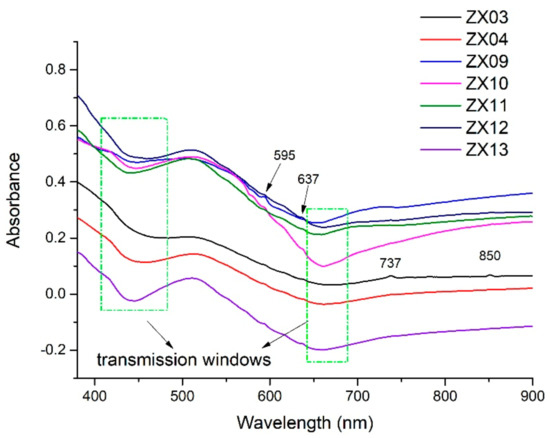
Figure 6.
UV-Vis-NIR spectra of these CVD synthetic diamonds show strong absorption due to the NV centre. In addition, defects such as 595 nm were detected.
3.2.3. PL Spectra
Many PL emission lines were recorded using five laser excitations in the UV–Vis–NIR region.
With the 325 nm laser, all samples showed a sharp 388.9 nm peak, but there were no 415 nm lines. The sharp line at 388.9 nm and the related broad bands at ~400 and ~410 nm (Figure 7a) were attributed to the 389 nm centre, which previously has been associated with radiation damage in all types of diamond and is stronger in those containing single nitrogen [14]. In one sample, an extremely weak GR1 peak could be seen.
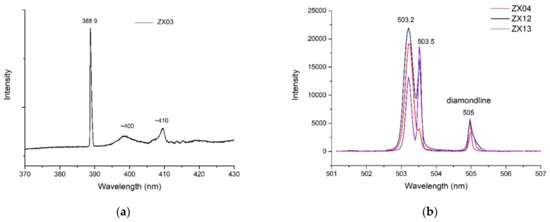
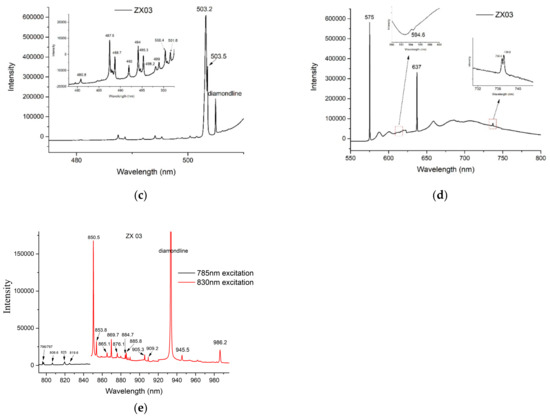
Figure 7.
Numerous emission lines are present in the PL spectra of these synthetic diamonds. Distinct 388.9 nm peak could be detected in all the samples with the 325 nm laser excitation (a). Several emissions and relatively strong H3 and 3H peaks in the 480–510 nm regions were observed with the 473 nm laser excitation (b,c). Extremely strong NV emissions and negative 594.6 nm reported with the 532 nm laser excitation (d), and many emissions including 986.2 and 945.5 nm when excited by the 785 and 830 nm lasers (e).
With blue laser excitation (473 nm; Figure 7b,c), all samples displayed distinct 503.2 (H3) and 503.5 nm (3H) peaks. The intensity of 3H varied significantly between samples and did not show a clear correlation with other absorption or emission features. The 3H peak was clearly separated from H3 in all samples. In five samples, the H3 was stronger than 3H; in two samples, H3 was weaker than 3H. Most samples displayed a group of sharp peaks at 480.8, 487.5, 488, 488.2, 488.7, 492, 494.1, 495.3, 498.2, 498.9, 500.4, and 501.6 nm (Figure 7c), whose structures are still unknown.
Green laser (532 nm) excitation revealed strong NV centre emission systems in all samples, with ZPLs at 575 and 637 nm (Figure 7d). The 575 nm line was generally stronger. The 575/637 intensity ratio ranged from 2 to 15.
Doublet emission at 596.5 and 597.0 nm has been documented as a common feature of colourless, near-colourless, and brown CVD synthetic diamonds [10], but it was not detected in this group of pink CVD lab-grown stones. Instead, a negative peak at 594.6 nm, which was easily detected with UV–Vis absorption spectroscopy, was observed in the PL spectra. These negative peaks are actually caused by absorption features present when a luminescence spectrum is collected [4]. A very weak 737 nm doublet line resulting from Si-related defects could be detected with 532 nm laser excitation in only two samples. No emission from GR1 (741.2 nm) was observed in any of the samples.
With the 785 or 830 nm laser excitation, many luminescence lines could be detected, including 796/797, 806.6, 819.6, 825.0, 850.5, 853.8, 869.7, 843.5, 853.8, 869.7, 876.1, 884.7, 885.8, 909.2, 945.5, 962.3, 970.7, 982.6, and 986.3 nm (Figure 7e). All the samples displayed 986.3 nm (H2), 850.5, and 853.8 nm lines. All but one displayed the distinct 945.5 nm line.
4. Discussion
The pink CVD lab-grown diamonds examined here are notably different from previous gem-quality pink CVD products: they display a stronger pink or orange–pink colour and are more attractive than those reported before [1,4]. Although the colour distribution is even, the pink hue has lower saturation and is modified by a purple or orange colour.
The pink colouration of these CVD samples is caused mainly by NV centres, which absorb most yellow, green, and orange wavelengths. Two transmission “windows” are created in two main regions: one at a slightly higher wavelength than 637 nm, introducing a pink-to-red hue component to the body colour; and the other centred at ~450 nm, passing blue light and thus producing a blue component.
The pink CVD synthetic diamonds in this study displayed weak H-related absorptions that occurred predominantly at 3107 and 3030 cm−1, while the 3123 and 3323 cm−1 peaks were weak or nearly absent, which is often the case in as-grown CVD diamonds (Figure 5b). When the CVD lab-grown diamonds are heat-treated at temperatures over 1200 °C [4,15], the 3123 and 3323 cm−1 peaks often disappear or decrease strongly in intensity, and the 3107 and 3030 cm−1 peaks begin to appear. Based on the result of Charles S.J. [16], the 3030 cm−1 peak appeared at the temperature of 1900 °C and annealed out at the temperature of 2200 °C; the 3107 cm−1 was not present in the spectra of the as-grown CVD diamonds and appeared at a temperature over 2200 °C. In our samples, the 3123 cm−1 peak could coexist with the 3030 cm−1 peak but not with the 3107 cm−1 line. Thus, we may assume that these diamonds should be annealed at a temperature of around 2000–2100 °C before they are irradiated and annealed to a pink colour. The detailed structure of the 3030 cm−1 defect is still unknown and may be related to defects containing both hydrogen and nitrogen [17].
We detected irradiation-related defects both in near-infrared and mid-infrared regions. Weak absorption caused by H1a at 1450 cm−1 (again, see Figure 7), which has been attributed to an interstitial defect seen in irradiated diamonds in a previous study [18], was observed in all samples. In the near-IR region, an absorption feature at 1077 nm (or 9282 cm−1) was observed in all the pink CVD diamonds, distinct in two samples and weak or very weak in the other two. The 1077 nm feature was not associated with nitrogen, but was possibly related to a multi-vacancy complex [14]. Wang et al. [4] reported that pink CVD diamonds display both 1450 and 1502 cm−1 peaks and they have a positive correlation in intensity, which suggests that the 1502 cm−1 centre is also related to this defect centre. However, because the 1450 cm−1 band may be weaker, we did not detect the 1502 cm−1 band in any of our samples.
We could observe the 388.9, 503.5, and 595 nm defects related to irradiation in the UV–Vis and/or PL spectra (Figure 7a–c), but we could not observe the ND1 defect documented by Wang et al. [4]. We could only detect a very weak GR1 peak in one sample when excited with the 325 nm laser. Furthermore, there were no doublet emissions at 596 and 597 nm in the PL spectra, indicating that these samples experienced high-temperature annealing [10].
The 388.9 nm centre is the radiation damage product characteristic of all types of diamonds [14]. Isotope studies show that the defect is related to single nitrogen and interstitials [19]. The 388.9 nm centre is detectable immediately after irradiation (but is very weak), and it increases considerably in strength following annealing to around 800 °C (Collins pers. Comm. 2020). We could see the 388.9 nm PL in the pink diamonds, but not the blue diamonds (Song et al. 2020), because the blue CVD diamond was not annealed but the pink CVD diamond was heated to around 800 °C. At the same time, it is possible that the pink diamond contains more single nitrogen than the blue CVD diamonds documented by Song Z. [8].
The 3H centre (503.5 nm), observed in all types of diamond after electron irradiation, is believed to involve the self-interstitial [20]. The annealing eliminated nearly all the GR1 PL but the 3H still could be detected obviously in all the stones. The GR1 centre often anneals out at a temperature of 800 °C, which means that the 3H centre is more stable than the GR1 and can exist at temperatures higher than 800 °C. No obvious dependence of 3H intensity on nitrogen concentration was found in this study. Steeds et al. [21] observed that the self-interstitials eliminate the Si-V centre; therefore, 737 nm peaks were extremely weak in two samples and even could not be seen in most samples that we studied. The 503.5 nm peak is always accompanied with local modes at 540.7, 543.8, 544.8, and 552.4 nm [21], but in our irradiated and annealed pink CVD diamonds, we could not observe any of them.
The 595 nm line can be seen both in the UV–Vis spectrum and negatively in the PL spectrum when excited with 473 and 532 nm laser excitation. The 595 nm line is often found in irradiated and annealed (T < 1000 °C) type Ia or Ib diamonds [13].
We also could observe the H3, H2, 575, and 637 nm defects related to high temperatures in the UV–Vis and/or PL spectra. A typical feature of the PL spectrum of the pink CVD-grown diamonds is the relatively strong H3 centre (Figure 7b). The intensity of the H3 peaks were around 3.3–6.5 times that of the diamond Raman line. The H3 defect ((NVN)0, 503.2 nm) forms in nitrogen-containing diamonds composed of an aggregate nitrogen and a vacancy. This defect is often found in diamonds that have been irradiated and annealed at relatively high temperatures [22,23]. Strong H3 emissions, as observed in the PL spectra of the orange-to-pink CVD samples in this study, indicated that some aggregated nitrogen had been formed during the post-treatment process.
All the samples displayed the H2 (986.2 nm) peaks in the PL spectra. The H2 centre is often found in diamonds containing aggregated and single nitrogen simultaneously and those subjected to a higher-temperature process [22]. The intensity of the H2 was around 0.01–0.02 times that of the diamond Raman line and it was extremely weak relative to the intensity of the H3 peak.
When single-nitrogen-containing diamonds are irradiated and annealed at a medium temperature, the vacancy will be captured by nitrogen and form a new centre, the NV centre, which produces 575 and 637 nm peaks. In this study, the NV centres were dominant in the PL spectra, and the intensity of 575 nm was stronger than that of 637 nm. The NV emission was the main cause of the pink colour and the obvious orange–red fluorescence.
5. Conclusions
Highly saturated natural pink diamonds are rare. Separation of these treated pink CVD lab-grown diamonds from other pink diamonds can be challenging, as some samples may be mistaken for other types of diamonds when using various gemological and spectroscopic features. The concentration of nitrogen is less than 1 ppm, which means that samples can easily be mistaken for type IIa diamonds without detected nitrogen from the IR spectrum. Otherwise, the typical CVD absorption peaks at 3123 and 3323 cm−1 are usually extremely weak or disappear entirely; the growth structures under DiamondView are always obscure, all of which may lead to an uncertain conclusion. However, the outstanding gemological features of this group of pink CVD synthetic diamonds include a black inclusion with irregular morphologies and/or pinpoint inclusions, weak but distinct 737 nm doublet lines, and the coexistence of the 3030 and 3107 cm−1 defects. These are key features in separating these CVD-grown diamonds from other pink-to-red diamonds, either natural or colour-treated.
Proper identification of this gem material can be achieved through a combination of standard gemological properties and characteristic spectroscopic features. There is no doubt that the CVD growth technique will continue to improve, and CVD synthetic diamonds of increasingly superior quality will be produced.
Author Contributions
Conceptualization, Z.S.; methodology, Z.S.; investigation, B.G. and H.D.; writing—original draft preparation, Z.S.; writing—review and editing, Z.S.; visualization, W.Z.; project administration, Z.S. All authors have read and agreed to the published version of the manuscript.
Funding
This research was funded by the NGTC Research Foundation, grant number NGTC20200300, and partially funded by the China National Science Foundation, grant numbers 41473030, 41272086, and 42073008.
Institutional Review Board Statement
Not applicable.
Informed Consent Statement
Not applicable.
Acknowledgments
We thank Alan Collins for supplying pers. comms. mentioned above and Hongming Liu of HuZhou Sino-C Semiconductor Co., who supplied all the samples for study.
Conflicts of Interest
The authors declare no conflict of interest.
Abbreviations
| CVD | chemical vapor deposition |
| HPHT | high-pressure high-temperature |
| GR | general radiation |
| ZPL | zero phonon line |
| NV | nitrogen vacancy |
| LW | longwave |
| SW | shortwave |
References
- Wang, W.; Hall, M.S.; Moe, K.S.; Tower, J.; Moses, T.M. Latest-generation CVD-grown synthetic diamonds from Apollo Diamond Inc. Gems Gemol. 2007, 43, 294–312. [Google Scholar] [CrossRef]
- Kitawaki, H.; Emori, K.; Hisanaga, M.; Yamamoto, M.; Okano, M. Speaker Presentations: LPHT-Treated Pink CVD Synthetic Diamond. Gems Gemol. 2018, 54, 267. [Google Scholar]
- Wang, W. Pink CVD synthetic diamond. Gems Gemol. 2009, 45, 137–138. [Google Scholar]
- Wang, W.; Doering, P.; Tower, J.; Lu, R.; Eaton-Magaña, S.; Johnson, P.; Emerson, E.; Moses, T.M. Strongly colored pink CVD lab-grown diamonds. Gems Gemol. 2010, 46, 4–17. [Google Scholar] [CrossRef][Green Version]
- Moe, K.S.; D’Haenens-Johansson, U.; Wang, W. Lab Notes: LPHT pink CVD synthetic diamonds. Gems Gemol. 2015, 51, 182–183. [Google Scholar]
- Eaton-Magaña, S.; Shigley, J.E. Observations on CVD-grown synthetic diamonds: A review. Gems Gemol. 2016, 52, 222–245. [Google Scholar] [CrossRef]
- Song, Z.; Lu, T.; Lan, Y.; Shen, M.; Ke, J.; Liu, J.; Zhang, Y. The identification features of undisclosed loose and mounted CVD synthetic diamonds which have appeared recently in the NGTC laboratory. J. Gemmol. 2012, 33, 45–48. [Google Scholar] [CrossRef]
- Song, Z.; Lu, T.; Liu, H.; Dai, H.; Ke, J.; Zhu, W.; Zhang, J. Identification of IIa blue CVD synthetic diamonds from HUzhou SinoC Semiconductor Co. in China. J. Gemmol. 2020, 37, 306–313. [Google Scholar] [CrossRef]
- Lu, T.; Ke, J.; Lan, Y.; Song, Z.; Zhang, J.; Tang, S.; Su, J.; Dai, H. Current status of Chinese synthetic diamonds. J. Gemmol. 2019, 36, 748–757. [Google Scholar] [CrossRef]
- Martineau, P.M.; Lawson, S.C.; Taylor, A.J.; Quinn, S.J.; Evans, D.J.F.; Crowder, M.J. Identification of synthetic diamond grown using chemical vapor deposition (CVD). Gems Gemol. 2004, 40, 2–25. [Google Scholar] [CrossRef]
- Howell, D. Strain-induced birefringence in natural diamond: A review. Eur. J. Miner. 2012, 24, 575–585. [Google Scholar] [CrossRef]
- Lawson, S.C.; Fisher, D.; Hunt, D.C.; Newton, M.E. On the existence of positively charged single-substitutional nitrogen in diamond. J. Phys. Condens. Matter 1998, 10, 6171–6180. [Google Scholar] [CrossRef]
- Woods, G.; Collins, A.T. New developments in spectroscopic methods for detecting artificially coloured diamonds. J. Gemmol. 1986, 20, 75–82. [Google Scholar] [CrossRef]
- Zaitsev, A.M. Optical Properties of Diamond, 1st ed.; Springer: Berlin/Heildelberg, Germany, 2001; pp. 50, 134, 328–332. [Google Scholar]
- Wang, W.; D’Haenens-Johansson, U.; Johnson, P.; Moe, K.S.; Emerson, E.; Newton, M.E.; Moses, T.M. CVD synthetic diamonds from Gemesis Corp. Gems Gemol. 2012, 48, 80–97. [Google Scholar] [CrossRef]
- Charles, S.J.; Butler, J.E.; Feygelson, B.N.; Newton, M.E.; Carroll, D.L.; Steeds, J.W.; Darwish, H.; Yan, C.-S.; Mao, H.K.; Hemley, R.J. Characterization of nitrogen doped chemical vapor deposited single crystal diamond before and after high pressure, high temperature annealing. Phys. Stat. Solidi (a) 2004, 201, 2473–2485. [Google Scholar] [CrossRef]
- Zaitsev, A.M.; Moe, K.S.; Wang, W. Defect transformations in nitrogen-doped CVD diamond during irradiation and annealing. Diam. Relat. Mater. 2018, 88, 237–255. [Google Scholar] [CrossRef]
- Collins, A.T.; Davies, G.; Kanda, H.; Woods, G.S. Spectroscopic studies of carbon-13 synthetic diamond. J. Phys. C Solid State Phys. 1988, 21, 1363–1376. [Google Scholar] [CrossRef]
- Collins, A.T.; Woods, G.S. Isotope shifts of nitrogen-related localised mode vibrations in diamond. J. Phys. C Solid State Phys. 1987, 20, L797–L801. [Google Scholar] [CrossRef]
- Kiflawi, I.; Collins, A.T.; Iakoubovskii, K.; Fisher, D. Electron irradiation and the formation of vacancy–interstitial pairs in diamond. J. Phys. Condens. Matter 2007, 19, 046216. [Google Scholar] [CrossRef]
- Steeds, J.W.; Davis, T.J.; Charles, S.J.; Hayes, J.M.; Butler, J.E. 3H luminescence in electron-irradiated diamond samples and its relationship to self-interstitials. Diam. Relat. Mater. 1999, 8, 1847–1852. [Google Scholar] [CrossRef]
- Collins, A.T. Colour centres in diamonds. J. Gemmol. 1982, 18, 37–75. [Google Scholar] [CrossRef]
- Collins, A.T. The colour of diamond and how it may be changed. J. Gemmol. 2001, 27, 341–359. [Google Scholar] [CrossRef]
Publisher’s Note: MDPI stays neutral with regard to jurisdictional claims in published maps and institutional affiliations. |
© 2021 by the authors. Licensee MDPI, Basel, Switzerland. This article is an open access article distributed under the terms and conditions of the Creative Commons Attribution (CC BY) license (https://creativecommons.org/licenses/by/4.0/).